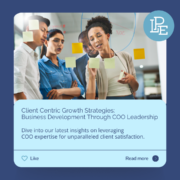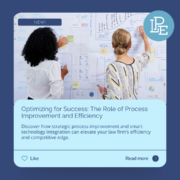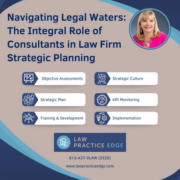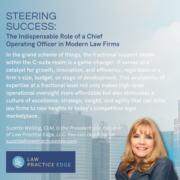
 In an increasingly complex and competitive legal marketplace, law firms are recognizing the necessity for more business-oriented strategies. Gone are the days when reputations alone could guarantee a steady stream of clients. In today’s environment, strategic planning – the art and science of bridging a firm’s current operations with its future direction – has become critical. Here, a law firm management consultant emerges as a lighthouse guiding firms through uncharted territories. These professionals play an integral role in shaping a law firm’s strategic trajectory, ensuring not just survival, but prosperity. The right consultant will be able to provide the following:
In an increasingly complex and competitive legal marketplace, law firms are recognizing the necessity for more business-oriented strategies. Gone are the days when reputations alone could guarantee a steady stream of clients. In today’s environment, strategic planning – the art and science of bridging a firm’s current operations with its future direction – has become critical. Here, a law firm management consultant emerges as a lighthouse guiding firms through uncharted territories. These professionals play an integral role in shaping a law firm’s strategic trajectory, ensuring not just survival, but prosperity. The right consultant will be able to provide the following:
Understanding the Legal Landscape
A consultant specializing in law firm management comes equipped with a deep understanding of the legal industry’s nuances. They monitor trends, regulatory changes, emerging technologies, and competitive forces. By conducting comprehensive market analyses, consultants can identify both opportunities for growth and potential threats, serving as the foundation for informed strategic decision-making.
Objective Assessment of Current Practices
Often, law firms operate with an internal perspective, unaware of inefficiencies or outmoded practices eroding their competitiveness. The right consultant can provide an objective, third-party evaluation of current operations, from workflow efficiency, client relationship management, to profit margins. By highlighting areas needing improvement, they pave the way for transformative solutions.
Facilitating a Culture of Strategic Thinking
One key obstacle in strategic planning is the resistance to change, common within traditionally hierarchical legal settings. Good consultants are adept at fostering a culture that values strategic thinking, facilitating workshops, and discussions that engage staff at all levels. They nurture an environment where innovative ideas are valued, contributing to the firm’s strategic vision.
Formulating a Strategic Plan
Armed with insights and comprehensive analysis, consultants guide the firm through the creation of a strategic plan. This roadmap is not just a theoretical document but a practical guide that includes specific goals, responsibility assignments, timelines, and measurable outcomes. It covers various facets from business development, operational efficiency, financial management, to technology adoption, ensuring a holistic strategy. By engaging a good strategic planning consultant, you will have a partner in ensuring that plans are not just formulated but successfully implemented.
Implementing Technology Solutions
In an era where legal tech is revolutionizing practice, a consultant’s role in guiding firms through digital transformation is crucial. They assist in identifying technology solutions aligned with the firm’s goals, facilitating their integration into everyday practice.
Performance Monitoring and Feedback
A strategic plan is a living entity, requiring regular nurturing through review and adjustment. Consultants assist in establishing Key Performance Indicators (KPIs) and implement monitoring mechanisms to track progress. Through continuous feedback, they help firms adapt to changing circumstances, ensuring the strategy remains relevant and effective.
Client Development and Retention
Consultants understand that at the heart of every law firm are its clients. They aid in developing strategies that enhance client satisfaction and loyalty. By refining client intake processes, communication, and value delivery, consultants help firms build a robust client base, crucial for long-term success.
Training and Development
Implementing new strategies often requires skills enhancement. Consultants often oversee training programs, ensuring the firm’s personnel are equipped to execute the strategy effectively. They help bridge any knowledge gaps, particularly in adopting new technologies or practices.
Preparing for the Future
Finally, consultants assist law firms in future-proofing their operations. Through succession planning, talent acquisition strategies, and predictive analyses of legal market trends, they ensure that the firm is prepared for the challenges of tomorrow.
By leveraging a management consultant’s expertise, law firms can embark on a strategic journey characterized by informed decision-making, innovative practices, and a proactive approach to market dynamics. In an industry where standing still is equivalent to moving backward, engaging with the right consultant provides the law firm with catalysts needed for forward motion, steering law firms toward a successful, sustainable future.
In the constantly evolving landscape of legal practice, the role of a Chief Operating Officer (COO) in law firms has shifted from an operational sideline to a strategic centerpiece. Law firms, traditionally centered around legal expertise, often overlook the necessity of robust, professional business management. However, as the legal market becomes increasingly competitive and complex, the need for a COO’s business acumen has never been more pronounced.
Below, we delve into the pivotal benefits of having a COO in a law firm and how this role can be a game-changer in navigating the firm’s growth, efficiency, and overall success.
- Strategic Business Planning: Beyond Legal Expertise
Legal prowess alone no longer sets a law firm apart in the crowded marketplace. A COO brings a critical perspective to strategic planning, ensuring that the firm’s business strategy aligns with its legal goals. They guide the firm in making key business decisions, planning long-term growth, identifying areas for investment, and recognizing potential market threats or opportunities, thus ensuring the firm isn’t just legally proficient but also competitively viable.
- Enhancing Operational Efficiency
Efficiency isn’t just a buzzword—it’s a competitive advantage. A COO examines the firm’s overall operations, identifying bottlenecks that might not be evident to legally-trained eyes. They streamline processes, integrate advanced technology, and can lead digital transformation efforts, ensuring the firm is agile and adaptable. This operational tightening directly contributes to client satisfaction, as services become swifter, more reliable, and cost-effective.
- Financial Oversight and Profitability Management
The COO often oversees the firm’s financial health, providing expert management that goes beyond basic accounting. This role involves comprehensive budgeting, financial planning, cash flow management, and profitability analysis. By understanding and monitoring the economic pulse of the firm, the COO supports sustainability and guides strategic decision-making, ensuring resources are effectively allocated for long-term profitability and stability.
- Navigating Change and Innovation
Whether adapting to legal industry shifts or global market changes, law firms must be nimble and innovative. A COO helps law firms navigate through periods of transformation and uncertainty. They can drive innovation, often bringing fresh, external perspectives to traditional practices, and ensuring the firm remains relevant and ahead of the curve. This proactive stance is crucial for embracing change and fostering a culture of continuous improvement and resilience.
- Enhancing Client Relations and Business Development
A law firm thrives on its client relationships. COOs play a vital role in shaping client strategy, improving client retention, and identifying new business opportunities. They ensure that the firm meets its clients’ evolving needs, improving client service models, and using data-driven insights to enhance relationships. Additionally, their outsider perspective plays a crucial role in business development, often seeing untapped markets or potential clients that those deeply entrenched in legal intricacies might miss.
- Fostering Collaboration
A law firm’s success relies on seamless collaboration between its various departments. Even in a small firm, the COO acts as a linchpin, ensuring departmental alignment with the firm’s broader business objectives. They facilitate communication and collaboration among departments, breaking down silos, and creating a more unified, cohesive organizational culture. This holistic approach ensures that every department’s efforts contribute to the firm’s collective success.
- Risk Management
In an era of increased regulatory scrutiny and rapid change, risk management is crucial. COOs bring a business-focused approach to risk, analyzing operational, financial, and strategic risks. Their oversight helps the firm mitigate these challenges, plan for contingencies, and build a solid foundation for the firm’s security and operational integrity.
The role of a Chief Operating Officer in a law firm transcends operational responsibilities, impacting strategic direction, firm culture, client relationships, and long-term sustainability. Law firms looking to thrive in today’s complex, competitive landscape will find the expertise and vision of a COO not just beneficial but essential. By investing in this leadership role, law firms are poised to navigate change effectively, leverage opportunities, and secure a position at the forefront of the legal industry’s future.
Ready for an encouraging update in this narrative? The modern marketplace is witnessing a transformative phase with the advent of fractional executive services, making C-suite expertise accessible to organizations across the board. This development means that operational oversight, once a luxury for large-scale legal enterprises, is now within reach for law firms of every size and capacity.
The implications of this trend are profound and multifaceted. Firstly, it democratizes access to strategic brilliance and experience. Smaller firms can harness the leadership and vision of a COO without the financial strain of a full-time executive position. This access helps level the playing field, offering smaller or mid-sized firms the fighting chance they need to compete effectively in a sector historically dominated by legal juggernauts.
Moreover, the availability of fractional C-suite services alleviates the overwhelming burden often shouldered by internal managers. Typically, these individuals juggle day-to-day operational responsibilities alongside more complex, strategic duties—a balancing act that dilutes focus and hampers innovation. By delegating executive and strategic roles to fractional COOs, internal managers can find respite from the relentless multitasking. This focused approach enables them to channel their energies more productively, ensuring attention to detail where it matters most and fostering an environment where strategic projects and process improvements receive the dedicated efforts they deserve.
In addition to providing relief for overstretched personnel, bringing a fractional COO on board affords an outside perspective that can be invaluable. These seasoned professionals often bring diverse experiences and insights from various sectors beyond the legal realm, contributing to a rich exchange of ideas and strategies. This diversity can be particularly beneficial in steering law firms away from insular thinking and towards a more holistic, innovative approach to their business operations.
In the grand scheme of things, the fractional support model within the C-suite realm is a game-changer. It serves as a catalyst for growth, innovation, and efficiency, regardless of a firm’s size, budget, or stage of development. This availability of expertise at a fractional level not only makes high-level operational oversight more affordable but also stimulates a culture of excellence, strategic insight, and agility that can drive law firms to new heights in today’s competitive legal marketplace.
Suzette Welling, CLM, is the President and Founder of Law Practice Edge, LLC. You can reach her at suzette@lawpracticeedge.com.
As a law firm partner, your compensation is likely one of the most important factors in your professional life. It determines your financial stability, allows you to provide for your family, and can even impact your ability to advance within the firm. However, understanding law firm partner compensation can be complex and confusing, as it is often based on a variety of factors and may vary significantly from one firm to another.
Law firms often have complex systems in place to determine how partners are compensated for their work. These compensation plans can vary widely from firm to firm and can be based on a variety of factors, such as the partner’s client origination, the partner’s billable hours, and the overall profits they generate for the firm.
Elements of Partner Compensation
Law firm partner compensation generally consists of two main components: salary and a share of the profits. The salary component is typically a fixed amount that is paid to the partner on a regular basis, while the profit share is a percentage of the firm’s profits that is allocated to the partner based on their contributions to the firm.
The specific breakdown of these two components can vary significantly from one firm to another. Some firms may have a higher salary component and a lower profit share, while others may have a higher profit share and a lower salary. In general, firms with a higher profit share tend to have a more hierarchical structure, with partners at the top receiving a larger share of the profits.
Criteria for the “Right” Model
Whatever the plan, it should do more than split the pie: it should reinforce the behaviors and efforts the firm desires from its attorneys. When considering whether to make a change to the firm’s current plan, partners should consider whether the current system supports the firm’s goals and rewards partners appropriately. For example, the plan should:
- Provide the proper incentives and motivations to support firm’s core values and goals.
- Reward mutually beneficial effort and discourage actions that hurt the whole.
- Be equitable enough that it reduces partner dissatisfaction and can be perceived as fair by the partners.
- Retain the right people and allow those who don’t fit to move on.
What Gets Measured Gets Attention
With the above criteria in mind, some metrics partners may want to consider as they look at how they want to split firm profits include:
- Level of support the partner provides to the realization of firm goals;
- Quality service / client satisfaction;
- Contribution to the success of others / delegation and supervision, resulting in associate retention;
- Contributions to business development;
- Personal skill development / partner satisfaction, resulting in partner retention and lateral recruitment.
Types of Compensation Plans
- Parity: Profits are split equally.
- Lockstep: Compensation is based on tenure.
- Subjective: Compensation is set by executive committee based on subjective criteria.
- Formula: Often “eat what you kill.”
- Hybrid: Combination of any of the above plan types.
Parity (Equal Partnership)
Pros:
- Supports teamwork
- Shares risks of economic cycles
- Makes sure it is not just about the hard data
Cons:
- Does not reward stellar performers
- Does not typically work beyond the early years of the firm
- Inequity causes friction among partners
Lockstep
Pros:
- Rewards loyalty
- Facilitates teamwork and collegiality
- Eliminates conflict
Cons
- Does not reward stellar performers
- Often causes attorney turnover
- May tend to reward complacency
Subjective
Pros
- Can work well if committee is made up of fair minded individuals
Cons
- Tends to fail as larger numbers of attorneys mature in their rainmaking ability
Formula / “Eat What You Kill”
Pros
- Rewards partners for the work they bring in and handle
- Fosters retention of high producers
Cons
- Creates silos / poor culture
- Discourages collaboration
- Does not encourage cross-selling
Hybrid
Pros
- Takes into account multiple factors
- Allows credit to be given for positive firm-level contributions
Cons
- Must take care not to make it too complicated
Things to Consider in Choosing the Formula for Your Firm
What Gets Measured Gets Attention
- What firm values and goals do you wish to achieve?
- Do you want to encourage a sense of firm or competitive silos?
Impact of Having the Wrong Model
- Perceived inequities can result in firm breakups and partner departures
- Goals specific to the firm will not be met
Law firm partner compensation can be complex and varied, with a number of factors influencing the specific details of a partner’s compensation package. Ultimately, the best law firm partner compensation plan will depend on the specific needs and goals of the firm. It is important for law firms to carefully consider their options and choose a plan that aligns with their business objectives and rewards partners for their contributions to the firm.
Wondering How to Begin the Conversation?
We provide consulting services to law firms to assist in the delicate conversation regarding partner compensation. Schedule a free consultation, and ask about our partner survey that has helped other firms to start the conversation in an objective and productive way.
The Process Component
Consistency works. Identify your core processes and ensure that everyone is following them, and you will have an efficient, well-oiled machine. Don’t give this component adequate attention, and you will lose time, money, and control.
Having worked with many clients who are growing their firm from a single-attorney firm to a multiple-attorney firm, I have witnessed the frustrations that founding partners experience when trying to scale without having key processes in place, followed by all. If you are to have the ability to manage and grow your organization without feeling that you need to have your hands on every activity, you must have processes that work successfully for your firm identified and followed so that you can let go and allow your team to work your way.
Step 1: Identify Your Core Processes
To begin, meet with your leadership team to identify your core processes. Examples:
HR Process: How you recruit, hire, onboard, manage, review, promote, retain, and terminate people.
Marketing Process: How you reach your target audience to get your message to potential clients.
Sale Process: How you convert leads to engagements.
Operations Processes: How you provide services to your clients or customers. In a law firm, this includes onboarding clients and providing service to clients. You also want to consider the forms you use repeatedly in your practice based on practice area. As you consider your operations processes, think about how you can set your firm apart from your competitors.
Accounting Processes: Management of money flowing in and out of your firm, how your clients are billed, how your accounts receivable is managed, etc.
Step 2: Document the Steps in Your Processes
Once you have identified the core processes relevant to your organization and given them names that are meaningful to your team, you need to identify who on your team is accountable for documenting the steps in these processes. Refer back to your Accountability Chart to identify who should be assigned each of these areas.
When documenting your processes, you want to keep in mind the 20/80 rule. You want to document the 20 percent that accomplishes 80 percent of the results. In other words, keep it simple and easy to follow. As you simplify, you may often find that your core processes are too complex. This is your opportunity to look at how you can streamline. Put checklists in place where possible – do everything you can to ensure that your team members can follow these steps successfully.
Step 3: Package It
Once you have your steps documented, package them in a way that makes it easy for them to be consistently followed by everyone. Use visuals wherever possible. Consider this chart for the steps to be followed in onboarding new LEDES billing matters:

Once you have identified, documented, and packaged your core processes, they will be easily followed as you train existing employees and onboard new ones. The better you do with this component, the easier it will be for your leadership to manage the high-level responsibilities they should be managing and let go of the minutiae as the appropriately responsible team handles your processes.
For assistance with your strategic planning, contact Suzette@LawPracticeEdge.com. For more information on the EOS system, check out Gino Wickman’s book Traction.
The Issues Component
“Problems are like mushrooms. When it’s dark and rainy, they multiply. Under bright light, they diminish.” Gino Wickman
The key to addressing and correcting the issues that are keeping your organization from successfully reaching your goals is a safe environment that promotes open and honest communication. If your organization does not currently have a culture that supports this, you can get there. Encourage it. Encourage everyone to respectfully communicate their concerns and ideas for solutions. The more your team sees their peers openly sharing in a safe environment, the more others will follow.
When your team is sharing open and honest communication, your Issues List can become a tool for keeping all of your issues out in the open and organized in one place.
Three Types of Issues Lists in the EOS System
Long-term issues. These are items that cannot be tackled in a week or two but need to be documented so that they are not forgotten. Issues that can be addressed in the immediate quarter are placed on a quarterly list referred to as Rocks in EOS. Quarterly Rocks are assigned to individuals so that there is accountability assigned for seeing that these issues are addressed. Issues that are farther out in your planning can be placed on your V/TO so that they can be addressed in a future quarter when the timing is right.
Weekly Leadership Team Issues List. These items are to be addressed more immediately and are discussed during your weekly leadership team meetings. These are items that need to be resolved at the highest level.
The Departmental Issues List. These issues can be addressed at a departmental level v. the need for your highest level of leadership to address them. They are specific to a department in your organization and can be handled at that level, removing the need for leadership to have them on their immediate radar.
The Issues Solving Track
Identify the real issue. Often the stated problem is not the real issue (it’s not about the nail). By discussing the issue in your leadership or department meeting, you can dig down to the root of the problem. For example, you may have a stated issue that client Smith Corporation is a terrible client who never pays their bills on time. But as you investigate the problem more thoroughly, you discover that Smith Corporation has specific billing guidelines that are not being properly followed by your billing department, resulting in rejected invoices that must be corrected and resubmitted.
Discuss. This is where it is most important for everyone to be able to share in honest, respectful communication. Consider the above example. If your billing manager is someone who some individuals on your team want to protect, it is important that your team members know that it is safe for them to share concerns about that individual’s performance. Understand that it is okay to have healthy conflict in order for the best solution to come to light. It may be that your billing person in this example has too much on their plate, keeping them from successful performance through no fault of their own. Without open and honest discussion, you cannot find a solution to your issue.
Solve. The solve step is a conclusion or solution that typically becomes an action item for someone to do. This action item ends up on the To Do list so that it is accomplished with accountability assigned, and the issue gets resolved. In the example discussed here, your firm administrator may be assigned to work with your billing person to identify where they need help.
Keys to Successful Issue Solving
You cannot always rule by consensus. Every team needs a quarterback. Consensus management does not work. When you are unable to come to a decision where everyone agrees, someone has to make the final decision. Once the final decision has been made, you must present a united front moving forward.
Be strong. The right decision is not always easy to implement. You must be willing to make the tough decisions.
Be decisive. The inability to make a decision can be your worst enemy. Successful businesses share the quality of making decisions quickly and changing them slowly.
Do not rely on secondhand information. You cannot solve an issue involving multiple people without all of the parties present. If they are not currently available, schedule a time when they are.
Fight for the greater good. Focus on the vision for the organization. Decisions cannot be made for the benefit of one individual over the benefit of the organization as a whole.
Do not try to solve everything. Prioritize your issues. You will never solve them all. Solve the most important issue first, and then move on to the next.
Live with it, end it, or change it. When you have an issue, you have to decide which of these decisions you will make. If you are unhappy about something, end it or change it. If you are unwilling or unable to do either of these things, at least right now, then live with it and stop complaining. Complaining is a waste of time and gets you nowhere.
Take a shot. Propose a solution. Don’t wait around for someone else to do it. This is something that should be instilled in your culture. I have always had the policy that if someone comes to me with a problem or complaint, they should also be prepared with a suggested solution.

By having a protocol for openly and systematically identifying, addressing, and solving issues in your firm, you can move forward with meeting your vision and goals. In a future article, we will discuss how the L-10 meeting protocol in the EOS system will help you to address and resolve your issues in an efficient and successful way.
For assistance with your strategic planning, contact Suzette@LawPracticeEdge.com. For more information on the EOS system, check out Gino Wickman’s book Traction.
The Data Component
How do you keep your fingers on the pulse of your business? Do you know what KPIs (Key Performance Indicators) indicate strength or potential issues for your firm, and if so, do you know where they currently stand? Or do you base your understanding on something less specific, like whether there is enough money to pay the bills, or by what your managers are telling you?
There is safety in numbers. Basing your knowledge of how your business is doing on the subjective opinion of a manager who may be trying to reassure you regardless of the real picture is dangerous. In order to accurately measure the pulse of your business, you need a scorecard.
A scorecard is an accurate report of 5 to 15 high-level weekly numbers that gives you the ability to predict where you are headed. Everyone in your firm should have a number.
7 Advantages of Everyone Having a Number
Numbers cut through unclear, subjective communication between manager and direct reports. Consider two scenarios where you ask your firm manager how you are doing this month at converting leads to client engagements. (1) Her subjective opinion is “great!” (2) You have a goal of a 50% conversion rate, and she responds that average conversion rate is currently at 20%. You have a much clearer understanding of the true picture with scenario 2.
Numbers create accountability. If you have a goal of no more than 10% of your A/R being over 90 days, you are going to be looking to your billing manager for an explanation when your 90+ day A/R is at 30%. Your billing manager will understand that if the number is exceeding the 10% goal, he had better be studying the issue and looking for a solution.
Accountable people appreciate numbers. When you have the wrong people in the wrong seats, they will usually resist measurables. The right people in the right seats love clarity. Knowing what their specific KPIs are, they like being part of a culture where everyone is working together to be accountable for the firm’s success.
Numbers create clarity and commitment. If an employee knows what their number is and agrees that they can achieve it, you have a commitment. If they have a concern about their ability to hit their number, you have an opportunity to have a meaningful conversation that may bring to light issues you are unaware of.
Numbers produce results. What is measured gets attention.
Numbers create teamwork. When you have a team of individuals who are the right people in the right seats, they will work together to figure out how they can hit their numbers.
You can solve problems faster. When you have well defined numbers and a number is off track, you can take proactive measures to identify the problem and correct it.
Making Meaningful Use of Your Numbers
You have defined numbers for your firm, now what? Your firm should be using a system for tracking those defined goals and what number you are hitting each week, month, and YTD average. Reviewing this report should be part of your regular partner meetings – if you have numbers but no one is paying attention to how you are doing in meeting them, they are meaningless. If everyone knows the numbers are going to be monitored and discussed at partner meetings, they have more incentive to be accountable.
With a little effort in defining what numbers create success for your firm, you can have a clear, objective understanding of how you are doing at any point in time and take meaningful action to correct issues before they become a serious problem.
For assistance with your strategic planning, contact Suzette@LawPracticeEdge.com. For more information on the EOS system, check out Gino Wickman’s book Traction.
The People Component
As Jim Collins taught us in Good to Great, it all comes down to getting the right people into the right seats. We all know this to be true, but the EOS model helps us to put it in practice.
How do you know who the right people are for your firm? As part of the V/TO exercise we reviewed in Part 2of this series, we identified the need to define your firm’s core values. Having gone through this exercise, you can now easily identify the right people – they are the individuals who share your company’s core values. They thrive in your culture and make your organization a better place to be.
Now, how about those seats?
The Accountability Chart
Part of the EOS process is the important exercise of creating an accountability chart (what most of us refer to as an org chart, but with more thoroughly defined information). By identifying the different positions in your firm and what skills and traits are necessary to be successful in those positions, you are able to objectively determine whether an individual is in the right seat for their skill set and strengths.
Right Person, Wrong Seat
You may often find that you have the right person in your firm, but they are in the wrong seat. They are a pleasure to work with. They meet all of your firm’s core values. But despite every best effort, they are just not successful in their current position. They can’t be left to their own devices to work independently due to continuing errors, missed deadlines, etc. They are a drain on your resources because they require so much attention. You have to remember that decisions must be made for the greater good – the firm – above the welfare of any one individual. If you can find a position in your firm that plays to their strengths, move them. If you can’t, you need to stop preventing them from finding a place where they can be successful and respectfully release them.
Wrong Person, Right Seat
You will also often find that you have the wrong person in the right seat. They are stellar performers when it comes to their work product. They bill 2000+ hours and seem to make the firm a lot of money. Unfortunately, their behavior is such a poor fit in your culture that they breed discontent throughout the firm. You may think they are making you a lot of money with all of those billed hours, but you cannot quantify the lost productivity in others due to the constant frustrations they cause. They may also be a cancer that will spread to others in your firm. Eventually, if you don’t release the wrong person, the right people will leave to work where they can be with individuals who are a cultural fit.
Do They GWC Their Position?
Sometimes you have individuals who, on paper, should be successful in their position. If you are finding it difficult to pinpoint where the problem is, ask yourself these questions: Do they Get It? Do they Want It? Do they have the Capacity to Do It? It isn’t enough to have the skills necessary to perform successfully in a position. An individual needs to really get it – not just what they must do, but why it is important. They also need to want it. I once worked with an attorney who should have been a perfect employee. She was smart, pleasant, and checked all of the initial boxes. The problem was, she didn’t want it.
Hire Smart
Once you have the right people in the right seats, it is important to use your core values and accountability chart as guides when hiring new employees. You should hire, fire, review, reward, and recognize based on those core values. You will find that your hiring success ratio will increase if you evaluate applicants’ core values before their skills.
When you have successfully fit the right people into the right seats, you will find that all of the pieces have come together to create a cohesive and successful team.
For assistance with your strategic planning, contact Suzette@LawPracticeEdge.com. For more information on the EOS system, check out Gino Wickman’s book Traction.
The Vision / Tracking Organizer (V/TO)
Most business owners are aware of the importance of a company vision, even if they don’t take the time to create one. A vision gets everyone in the firm seeing the same clear message of where the business is going and how it is going to get there. For those who take the time to create a vision, I wonder how many keep it front and center on a regular basis, ensuring that the vision they have for the business is where they actually end up.
In Part 1 of this series, we talked about Gino Wickman’s book, Traction, and the EOS system he developed in order to help organizations not just create a strategic plan but actually work the plan into fruition. The initial part of the EOS system is the development of the Vision / Traction Organizer (V/TO). The process helps the organization to develop a vision but also put other parameters into place to help work toward that vision.
The Importance of Creating a Vision
You may wonder why you need to take the time to identify or verbalize the vision you have for your firm. You know what you want for your firm, so why take the time to work through the process of writing it all down? Consider these points:
- Having a clear vision for the firm that everyone understands gets everyone steering the ship in the same direction.
- Fail to provide this vision for everyone in your firm, and they lack a sense of purpose and are functioning as if on an island.
- The more clear your vision is to everyone, with everyone’s energy focused on the same thing, the more likely you will achieve it.
“If you could get all the people in an organization rowing in the same direction, you could dominate any industry, in any market, against any competition, at any time.” Author unknown
The 8 Questions of the V/TO
In order to create your organization’s clear vision, the V/TO provides support in identifying eight key areas:
- Core values
- Core focus
- 10-year target
- Marketing strategy
- 3-year picture
- 1-year plan
- Quarterly rocks
- Issues
Core Values
Well defined core values allow you to weed out people who don’t fit. Without the right people in the right seats, you will not find success. An organization should hire, fire, review, reward, and recognize based on its core values. Your hiring success ratio will increase significantly if you evaluate applicants based on their fit with your core values before their skills.
Core Focus
The core focus defines your two truths: your reason for being and your niche. By having a well defined core focus for your organization, you can easily make decisions about what cases you should take on and what cases you should pass on. Staying true to your core focus allows you to avoid being distracted by the shiny stuff. By having a clear vision of your core focus, you can avoid taking on cases that are not a good fit for you. Taking cases that do not make sense for your practice results in lack of efficiency, lack of profitability, and often lack of success. In addition, if you are busy working on the “wrong stuff,” you will not have the bandwidth to take on the cases that really matter to you when they arise.
“He who chases two rabbits catches neither.”
Ten-Year Target
Think BHAG: Big Hairy Audacious Goals. Don’t limit yourself here – shoot for the moon. It is better to have goals that are too big than to limit yourself by creating goals that are too small. Just ensure that the goals you set are specific and measurable so that your shorter-term goals can be specific enough to help lead you where you are trying to go.
Marketing Strategy
The EOS process will help you to be very specific in identifying your strategy. You will begin with four elements that identify who your firm is:
- Target Market
- Your Firm’s Three Uniques
- Your Firm’s Proven Process
- Your Guarantee
By taking the time to identify these traits that are unique to your firm, you will start to see a clear picture of how you can use your marketing strategy to help your firm stand out from the rest.
Once you have identified what sets your firm apart, the second part of your marketing strategy identifies who your clients are. You will want to identify these traits for your ideal clients:
- Geographic
- Demographic
- Psychographic
By identifying what makes your firm unique and who your ideal clients are, you can focus your marketing strategy and your attention on the right clients.
“If you try to please everyone, you’re going to lose your a**.”
Three-Year Picture
Your three-year picture begins to break down your ten-year goal into a more manageable picture. You will begin by creating some basic measurables: Gross revenue, net profit, number of new clients, etc. Once you have identified that measurable goals you have for where you want to be in three years, think about what your firm will need to look like in order to meet those measurables. For example:
- Number of attorneys
- Number of staff
- Added resources
- Systems
- Office size
One-Year Plan
Your one-year plan brings you into closer focus and should help you move toward your three-year picture. Create three to seven priorities to complete to be on track for meeting your three-year picture. These items should be specific, measurable, and attainable goals, and then ensure you have created a budget to support these goals.
Quarterly Rocks
In EOS, long-term tasks are called “rocks.” These 90-day goals are created in order to ensure that you will be on target in meeting your one-year plan. Like all of your other goals / tasks, they need to be specific, measurable, and attainable.
Rocks are assigned to individuals and/or departments. Your monthly partner meetings should address progress on assigned rocks to ensure that they do not fall by the wayside in the midst of busy practices. We will talk more about the EOS meeting structure in another article.
Issues
Finally, issues are obstacles that could stand in the way of accomplishing the vision you have defined for your firm. Issues are items that need to be addressed by your management team in order to identify solutions. Issues are discussed and resolved during your partner meetings in a well organized process defined by the EOS system.

Once your partners have defined these eight items, it is time to share the V/TO with your organization. You will achieve your full potential when your leadership team is on the same page. You will then be able to move your organization in one direction, rowing together to success.
For assistance with your strategic planning, contact Suzette@LawPracticeEdge.com. For more information on the EOS system, check out Gino Wickman’s book Traction.















